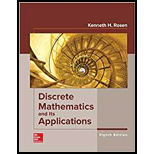
Concept explainers
Let
Want to see the full answer?
Check out a sample textbook solution
Chapter 13 Solutions
DISCRETE MATHEMATICS+ITS APPL. (LL)-W/A
- 3. Express each of these Boolean functions using the operatorsarrow_forwardPlease just answer parts iv. and v.arrow_forwardFind the complement of the following boolean functions and reduce them to minimum number literals, (1) (bc' + a'd) (ab' + cd') WA (ii) b'd + a'bc' + acd + a'bc owfen Garrow_forward
- There are 16 binary relations on the set {0, 1}: (a) { } (d) {(1,0)} (g) {(0, 0), (1, 0)} (j) {(0, 1), (1, 1)} (m) {(0,0), (0, 1), (1, 1)} (b) {(0, 0)} (e) {(1, 1)} (h) {(0, 0), (1, 1)} (k) {(1, 0), (1, 1)} (c) {(0, 1)} (f) {(0, 0), (0, 1)} (i) {(0, 1), (1,0)} (1) {(0,0), (0, 1), (1, 0)} (0) {(0, 1), (1, 0), (1, 1)} (n) {(0,0), (1,0), (1, 1)} (p) {(0, 0), (0, 1), (1, 0), (1, 1)} For a-f use the letters for each relation above. a. List the reflexive relations on the set {0, 1}. b. List the irreflexive relations on the set {0, 1}. c. List the symmetric relations on the set {0, 1}. d. List the transitive relations on the set {0, 1}. e. List the antisymmetric relations on the set {0, 1}. f. List the asymmetric relations on the set {0, 1}.arrow_forward3. Show that any language A is recognizable if and only if Aarrow_forward2. Let meN and a € Z. (a) If ged(a,m) = 1, then Bézout's lemma gives the existence of integersz and y such that ax + my = 1. Prove that a+mZ is the multiplicative inverse of a +mZ. (b) Determine the least nonnegative integer representative for (11+163Z)-¹ by expressing 1 as a linear combination of 11 and 163 (using the extended Euclidean algorithm).arrow_forwardcreate an equation showing the symbol (notation) introduced for the theoretical autocovariance of order 2. include the two lines of R script required to install and load the fpp3 package (do this in a verbatim environment)arrow_forwardConsider the following language over the alphabet Σ = {a, b} L = {w : nb(w) is even, na(w) is odd, and w does not contain the substring ba} 1. Design the minimal deterministic finite automata which recognizes L. You do not need to prove correctness nor minimality. 2. Provide regular expressions for each of the equivalence classes of ≡L. [Hint: Use your answer from 1. A conversion algorithm is not necessary.]arrow_forwardList the elements of U(20)/U5(20).arrow_forwardLet U = the set of all trees M(x) = "x is a Maple tree", E(x) = "x is an evergreen tree" %3D %3D Select all of the statements that are logically equivalent to: "It is not the case that for some tree, being an evergreen implies being a maple." (Ex E U, E(x) = M(x)) (Ax € U, E(x) → M(x)) Væ E U,¬ (E(x) = M(x)) Ξ0ευ,- (E(π) → M(x)) Vx E U, E(x) ^ ¬M(x) Jæ E U, E(x) ^ ¬M(x) Væ E U,¬M(x) ¬E(x) 3x E U, ¬M(x) → ¬E(x)arrow_forwardEXERCISE 1.13.3: Show an argument with quantified statements is invalid. Show that the given argument is invalid by giving values for the predicates P and Q over the domain (a, b). (a) x (P(x) → Q(x)) 3x - P(x) :: 3x -Q(x) 3x (P(x) v Q(x)) 3x -Q(x) :: 3x P(x) ~ Feedback?arrow_forwardMake a logic circuit of the following Boolean Function. • F(x, y) = xy + x • F(x, y, z) = xz + xyarrow_forwardarrow_back_iosSEE MORE QUESTIONSarrow_forward_ios
 Linear Algebra: A Modern IntroductionAlgebraISBN:9781285463247Author:David PoolePublisher:Cengage Learning
Linear Algebra: A Modern IntroductionAlgebraISBN:9781285463247Author:David PoolePublisher:Cengage Learning
